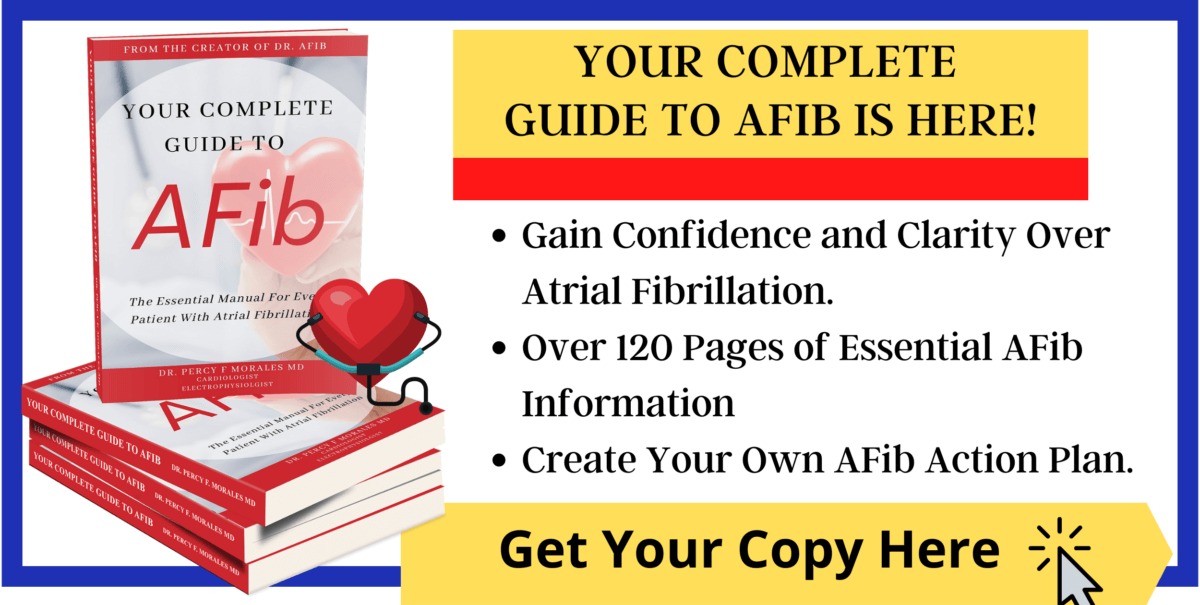Are you considering an ablation for AFib to control for your AFib symptoms? If so, this article is for you.
Treating atrial fibrillation is personal for each patient. Depending on your symptom severity and frequency, other medical comorbidities, and current medications, your treatment plan created with your medical team should be specialized to meet your unique needs.
In some cases, a patient may be able to manage their symptoms by taking medications and making lifestyle changes — but at other times, undergoing a minimally invasive procedure like a catheter ablation may be the best option for managing a patient’s AFib symptoms.
Looking to shed some more light on this popular AFib treatment option, this article discusses all the expected steps that occur during an AFib catheter ablation procedure while also sharing helpful tips and information about a typical ablation consultation appointment, how to prepare for the procedure, and what you can expect during the recovery process. I have performed many catheter ablation procedures on patients with AFib, so I want to give you my personal perspective on this common treatment option.
What is a Catheter Ablation for Atrial Fibrillation?
A catheter ablation is a minimally invasive procedure for treating atrial fibrillation. Since it is a minimally invasive procedure, it allows for a faster recovery time compared to more invasive heart surgeries for AFib, such a mini-maze or maze surgery procedure.
Catheter ablations can treat irregular or rapid heart rhythms like atrial fibrillation, atrial flutters, and supraventricular tachycardia (SVT). During the procedure, an electrode catheter is inserted into a vein in the groin (the femoral vein) and moved up to the heart, where it is able to target and damage specific areas of the heart that are causing the arrhythmias in a controlled and strategic fashion. When performed by an experienced electrophysiologist, this procedure can help to reduce the severity and frequency of your AFib symptoms, frequently leading to less medications as well.
What to Expect During a Consultation with Your Electrophysiologist
If you are considering having a catheter ablation to better manage your AFib symptoms, one of the first steps is booking a consultation appointment with an electrophysiologist. Electrophysiologists, like myself, are experts in heart rhythm disorders, such as AFib. Also called EPs, we are the doctors that typically perform catheter ablation procedures for AFib. During this appointment, you can expect your EP to ask you questions about your health and AFib symptoms, such as:
-
How long have you had atrial fibrillation?
-
How often do you get symptoms, and how severe are they?
-
What medications are you currently taking to treat your AFib? Is it working?
-
What other medical conditions do you have?
-
Have you had heart surgery before?
Based on your answers to the above questions, your provider will be able to provide more insight into your candidacy for the AFib ablation procedure. If they believe that you are a candidate for the procedure, they will also usually go over the following information at your consultation:
-
What happens during a catheter ablation
-
Instructions on what to do before and after the procedure
-
The potential risks and complications
-
Answering any of your remaining questions about the procedure
Your Complete Guide To AFib: The Essential Manual For Every Patient With Atrial Fibrillation
Preparation for an AFib Ablation Procedure
If you are a good candidate for a catheter ablation procedure, there are still a few steps you need to complete before you can book your surgery.
As an essential first step, planning to medically optimize your health before your surgery can help to reduce your risk of experiencing a complication. Examples of diagnostics tests and interventions that may be done to ensure that you are in good health before a catheter ablation include:
-
Monitoring your vitals and adjusting your medications as needed, particularly blood pressure medications.
-
Getting blood work done to test your blood counts and kidney function
-
Having a preoperative chest X-ray, MRI, or CT scan
In some cases, your doctor may also order a trans-esophageal echo (also called a TEE) the morning of your procedure to get detailed ultrasound images of your heart, as well as to exclude the presence of a blood clot in your heart prior to the procedure. All of the information collected before your surgery will be used by your doctor to develop the best strategy for your procedure.
The Potential Risks and Complications of a Catheter Ablation
Just like any other surgery or medical procedure, deciding to undergo a catheter ablation is not without risks. Despite being a minimally invasive procedure option that most patients recover from quite quickly, it is important to know that you may experience a potential complication if you choose to undergo a catheter ablation for your atrial fibrillation. In most centers, risks for major complications are less than 1%. If you have any questions about the procedure and its risk, you should speak to your doctor before your surgery date to ensure that you make the right choice for your needs.
Some of the most common risks and complications of a catheter ablation include:
-
Bleeding or getting an infection from the catheter insertion site
-
Damaging the lining of the vein or vessel used during the procedure
-
Puncturing the heart tissue, resulting in bleeding around the heart, sometimes requiring emergency drainage.
-
Post-operative blood clots
-
Narrowing or scarring of the vascular vessel used during the procedure
-
Complications from radiation exposure during surgery
-
Allergic reactions to the anesthesia medications
-
Damage to the esophagus (very close to the heart and area that is undergoing ablation)
To minimize the potential risks of choosing this treatment option, be sure to talk to your provider to ensure that you are physically fit for surgery and that the benefits of the procedure outweigh the risks to ensure your safety. Also, ask your doctor what precautions they take to minimize these risks.
What Happens During an Ablation Procedure for AFib?
On the day of your procedure, you will begin the day by meeting with a nurse to go over important preparation and recovery information. You and the doctor have had a chance to review your consent form and answer any last-minute questions. Once there, you can expect the following events to occur:
-
You will get an IV and meet your anesthesiologist — In most cases, your IV will be used to administer medications during the procedure. Speak with your anesthesiologist before your procedure if you have any questions about medications used for anesthesia. In the United States, most ablation procedures for atrial fibrillation are performed under anesthesia, as the process of burning or freezing inside the heart can be painful. However, the use of anesthesia is not always commonly used in other countries.
-
You will be connected to a series of vital monitoring equipment — Once on the operating room table, your provider will connect you to vital monitors to measure your blood pressure, heart rate, and blood oxygen levels throughout the procedure. There are also several additional equipments that you are connected through patches placed on your skin used during an AFib ablation, called 3 dimensional mapping, which allows your doctor to have greater precision while performing an ablation for AFib.
-
The hair will be shaved in several areas— As the primary insertion site for the catheter, the skin of your groin needs to be cleaned prior to surgery. This will involve removing any hair in the area and washing the skin with an antiseptic prep cleaner. In addition hair on your chest or back may also be shaved to allow for placement of monitoring equipment or patches placed on your chest and back during the procedure.
Pulmonary Vein Isolation: The Foundation for AFib Ablation Procedures.
Interested to know what happens after you go to sleep? In most cases, a standard catheter ablation occurs in the following three steps:
-
The procedure begins with your surgeon using a needle puncture to place the catheter into your femoral vein. In most cases, multiple punctures are made, as more than one catheter is used during the surgery.
-
Once in the femoral veins, your surgeon will gently advance the catheters to the heart. To treat atrial fibrillation, the surgeon needs to get the catheter into the left atrium of the heart. In order to get there, your doctor will need to do a trans-septal puncture, a technique used to create a very small hole to cross from the right upper chamber to the left upper chamber of your heart. This small hole typically heals on its own several weeks after the procedure. Advancements in equipment used for this procedure, particular the use of intra-cardiac echo (an ultrasound used inside of the heart through a catheter), have made this an overall very safe and routine part of the procedure.
-
Pulmonary Vein Ablation: After getting into position in the left atrium, the ablation procedure can begin. During the ablation, your surgeon will target the four primary pulmonary veins, which are connected to the nerves and heart tissue and can cause AFib symptoms, located in the back of the left atrium of the heart. Typically patients have 4 pulmonary veins that drain blood from your lungs back to your heart. These pulmonary veins have extensions of nerves and heart tissue that can trigger episodes of atrial fibrillation. This is a common source for most patient’s atrial fibrillation. As a result, the main goal during an ablation the primary goal is to make strategic scar inside your heart to block these triggers that can lead to episodes of atrial fibrillation. This scar does not affect the blood flow from the lungs back to your heart but blocks those trigger areas to reduce your atrial fibrillation.
Using radiofrequency (burning methods) or cryotherapy (freezing methods), your surgeon will make strategic scarring inside your heart to block these common AFib triggers. The goal is to have a thorough ablation performed of all 4 pulmonary veins during the procedure. This process usually takes up to three hours to complete. After completion of the pulmonary vein ablation, your doctor may do additional testing to see if you can still be induced into atrial fibrillation or another arrhythmia. What I tell patients is that this is the part that is customized per patient. Atrial fibrillation affects hearts in different ways, while inside of your heart your doctor can have a detailed assessment of how much atrial fibrillation has affected your heart, most commonly this is seen through the amount of scar tissue noted in your left atrium or by identifying additional triggers for atrial fibrillation which can be identified by giving a stimulant type medication such as Isuprel.
What to Expect After an Ablation:
Once your surgery is complete, you will be moved to the recovery room to wake up and rest. While there, you will also receive any medical care that you need post-operatively. Your doctor may order additional tests (like a chest X-ray and ECG) to assess any changes to your heart rhythm and function. In most cases, patients can return home the same day as the procedure.
As a minimally invasive procedure most patients experience a relatively short recovery after a catheter ablation. This being said, it is common for patients to experience some mild discomfort after the procedure, such as the following:
-
Mild soreness and bruising along the point of entry in the groin
-
Mild chest pain. Chest pain is usually inflammatory in nature ( worse with certain positions, laying flat, or with taking deep breaths). This pain usually responds well to anti-inflammatory medications.
-
Mild shortness of breath. Sometimes patients retain fluid after a catheter ablation and experience shortness of breath. At times, your doctor may prescribe a diuretic medication to help remove fluid.
-
If at any time during your recovery you experience severe pain, bleeding from the catheter insertion site, or develop crushing chest pain, please be sure to contact your provider ASAP for additional support.
Additionally, it is very normal for patients to notice that the most noticeable changes in their symptoms take up to 3-months to appear post-op. Because a catheter ablation causes intentional scar tissue in the heart, it takes time for the body to reduce inflammation and heal. During this early period, also called the “blanking period,” it is normal to experience recurrences of their AFib symptoms. This is why it is common for patients to remain on their AFib medications for a few months post-surgery to support the body as it heals. I usually wait at least one month after an ablation procedure before I attempt to decrease medications for AFib.
Frequently Asked Questions about AFib Ablation Procedures (FAQs)
When Should You have an Ablation for AFib?
In general, the earlier someone undergoes an ablation procedure for atrial fibrillation, the better the success rate of the procedure. Patients in earlier stages of AFIb, called Paroxysmal AFib (where AFib comes and goes, not in AFib all the time) usually have the best success rate with an ablation procedure. Recent literature has also suggested that patients who undergo an AFib ablation procedure within the first year after diagnosis have the best results.
How Long Does it Take to Recover From an AFib Ablation?
In most cases, a catheter ablation is a minimal invasive procedure. Because of this, patient recovery times are often relatively short, allowing patients to participate in light activity within 1-2 days of their procedure, with most patients feeling recovered with no symptoms within one week of their surgery. This being said, every patient is different — so if you notice that you are feeling additional pain or develop other complications of the procedure, be sure to speak with your primary care provider.
What is the Success Rate of an Ablation for Atrial Fibrillation?
Success of a patient’s catheter ablation depends on a variety of factors. In most cases, the long-term success rate of a catheter ablation in the treatment of AFib varies based on the type and duration of AF (paroxysmal vs. persistent AFib, for example), previous structural remodeling of the heart, and medical comorbidities. But, with all of this being said, the success rate of a catheter ablation for AFib ranges on average from 75-85% over 1-2 years of follow-up.
If Ablation Fails, What Next?
There are many options available when patients have recurrent AFib even after an ablation. Some patients can do very well with a combination of medications, such as anti-arrhythmic medication, even after an ablation procedure. My usual approach for patients who have recurrent AFIb after an ablation is to adjust medical therapy and place on an anti-arrhythmic medication, such as flecainide. In addition, there any many patients who will do very well with an additional ablation procedure. Up to 30% of patients who undergo an ablation procedure may need additional procedures to get very good control over AFib. In redo procedures, the electrophysiologist can touch up any areas that did not get thoroughly ablated in the first case or uncover additional areas that were not abated the first time. In addition, patients who have recurrent AFib after a traditional ablation procedure should also consider surgical ablation procedures for AFib, such as a mini-maze procedure. These procedures are more extensive than a traditional AFib ablation and with higher risks.
In addition there are many patients that can overcome recurrent AFib after an ablation with lifestyle modifications. Getting to the root cause of atrial fibrillation can help with recurrences after an ablation. For many people, this would involve weight loss, but also treating sleep apnea when applicable and cessation of alcohol can also help.
Read more about recurrent AFib after an ablation procedure here.
How Can I Improve the Success Rate of my Ablation Procedure?
Multiple studies have found that making lifestyle changes can have a positive impact on the success rate of a catheter ablation. Treating medical comorbidities like diabetes and heart disease, losing weight, and getting tested for sleep apnea are all steps that can be taken to help improve the success rate of your procedure.
Additional tips I have for making the most of your post-ablation recovery period include:
-
Ensuring that you take adequate rest, allowing your body a chance to heal
-
Eat a healthy and nutrient-dense diet
-
Avoid applying soaps and creams to the surgical site to reduce infection risk
-
Remain hydrated and avoid alcohol consumption during your recovery
-
Taking any heart and pain medications as prescribed
-
Avoid strenuous exercise for up to three weeks post-operatively
Want to learn more about applying these lifestyle modifications to improve your AFib? My article, The Ultimate Guide To Reverse AFib Naturally, is an excellent resource for those looking to get motivated about managing their AFib.
Putting it all together
A catheter ablation can be an excellent option for many patients with atrial fibrillation, especially in situations where patients continue with significant symptoms despite medications. But it is not perfect, recurrences can happen, and there are many patients that need more then one ablation to get good control over atrial fibrillation. But always discuss with your doctor the risks and benefits of a catheter ablation, and to see if it is the right option for you.
The Best Atrial Fibrillation Book
Your Complete Guide To AFib: The Essential Manual For Every Patient With Atrial Fibrillation

Shop AFib Products on Amazon
KardiaMobile 6-Lead Personal EKG Monitor – Six Views of The Heart – Detects AFib and Irregular Arrhythmias – Instant Results in 30 Seconds – Works with Most Smartphones - FSA/HSA Eligible
13% Off
KardiaMobile 1-Lead Personal EKG Monitor – Record EKGs at Home – Detects AFib and Irregular Arrhythmias – Instant Results in 30 Seconds – Easy to Use – Works with Most Smartphones - FSA/HSA Eligible
$79.00 (as of June 15, 2025 15:13 GMT -06:00 - More infoProduct prices and availability are accurate as of the date/time indicated and are subject to change. Any price and availability information displayed on [relevant Amazon Site(s), as applicable] at the time of purchase will apply to the purchase of this product.)
Apple Watch Series 9 [GPS 41mm] Smartwatch with Storm Blue Aluminum Case with Silver Sport Band M/L. Fitness Tracker, Blood Oxygen & ECG Apps, Always-On Retina Display
(as of June 15, 2025 08:34 GMT -06:00 - More infoProduct prices and availability are accurate as of the date/time indicated and are subject to change. Any price and availability information displayed on [relevant Amazon Site(s), as applicable] at the time of purchase will apply to the purchase of this product.)
Fitbit Sense 2 Advanced Health and Fitness Smartwatch with Tools to Manage Stress and Sleep, ECG App, SpO2, 24/7 Heart Rate and GPS, Shadow Grey/Graphite, One Size (S & L Bands Included)
20% Off
OMRON 2-in-1 Upper Arm Blood Pressure Monitor & 1-Lead EKG Monitor - Clinically Validated Blood Pressure Arm Cuff & Machine - Use OMRON Connect App
24% Off
Samsung Galaxy Watch 6 44mm Bluetooth Smartwatch, Fitness Tracker, Personalized HR Zones, Advanced Sleep Coaching, Heart Monitor, BIA Sensor, Health Wellness Insights, Big Screen, US Version, Graphite
$353.21 (as of June 15, 2025 20:21 GMT -06:00 - More infoProduct prices and availability are accurate as of the date/time indicated and are subject to change. Any price and availability information displayed on [relevant Amazon Site(s), as applicable] at the time of purchase will apply to the purchase of this product.)
Natural Rhythm Triple Calm Magnesium 150 mg - 120 Capsules – Magnesium Complex Compound Supplement with Magnesium Glycinate, Malate, and Taurate. Calming Blend for Promoting Rest and Relaxation.
$20.77 ($0.17 / Count) (as of June 15, 2025 17:47 GMT -06:00 - More infoProduct prices and availability are accurate as of the date/time indicated and are subject to change. Any price and availability information displayed on [relevant Amazon Site(s), as applicable] at the time of purchase will apply to the purchase of this product.)
Pure Encapsulations Magnesium (Glycinate) - Supplement to Support Stress Relief, Sleep, Heart Health, Nerves, Muscles, and Metabolism* - with Magnesium Glycinate - 180 Capsules
$44.60 ($0.25 / Count) (as of June 15, 2025 08:34 GMT -06:00 - More infoProduct prices and availability are accurate as of the date/time indicated and are subject to change. Any price and availability information displayed on [relevant Amazon Site(s), as applicable] at the time of purchase will apply to the purchase of this product.)
















![Apple Watch Series 9 [GPS 41mm] Smartwatch with Storm Blue Aluminum Case with Silver Sport Band M/L. Fitness Tracker, Blood Oxygen & ECG Apps, Always-On Retina Display #1](https://m.media-amazon.com/images/I/311xwtp4mFL._SL100_.jpg)
![Apple Watch Series 9 [GPS 41mm] Smartwatch with Storm Blue Aluminum Case with Silver Sport Band M/L. Fitness Tracker, Blood Oxygen & ECG Apps, Always-On Retina Display #2](https://m.media-amazon.com/images/I/41j+8AaUGsL._SL100_.jpg)
![Apple Watch Series 9 [GPS 41mm] Smartwatch with Storm Blue Aluminum Case with Silver Sport Band M/L. Fitness Tracker, Blood Oxygen & ECG Apps, Always-On Retina Display #3](https://m.media-amazon.com/images/I/41jIyxZitnL._SL100_.jpg)
![Apple Watch Series 9 [GPS 41mm] Smartwatch with Storm Blue Aluminum Case with Silver Sport Band M/L. Fitness Tracker, Blood Oxygen & ECG Apps, Always-On Retina Display #4](https://m.media-amazon.com/images/I/41IpNJERjCL._SL100_.jpg)
![Apple Watch Series 9 [GPS 41mm] Smartwatch with Storm Blue Aluminum Case with Silver Sport Band M/L. Fitness Tracker, Blood Oxygen & ECG Apps, Always-On Retina Display #5](https://m.media-amazon.com/images/I/31o17yhfYpL._SL100_.jpg)





































